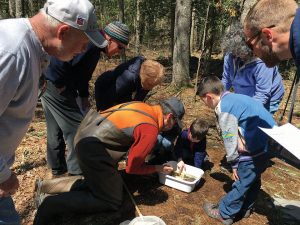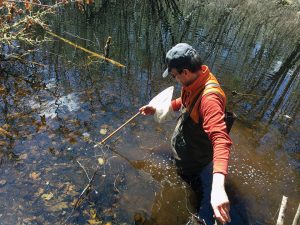On a rare and recent sun-drenched spring afternoon, Gary Johnson of the Mattapoisett Land Trust pulled on his waders, picked up his insect net, and led a group of nature-starved humans into the woods at the Woodcock Preserve.
This property, which has been owned by the MLT since the early 1970s, had been hard to access until more recently when the Town of Mattapoisett, in partnership with the Buzzards Bay Coalition, acquired what is now called the Tinkham Woods situated off Long Plain Road.
With entry now easily available to those longing to connect with Mother Nature, the Woodcock Preserve is home to an amazing nursery in the form of a certified vernal pool. On this day, young and old alike would learn from Johnson not only how important this wetland is to the future of some of the most endangered species in New England, but also how to go about the vernal pool certification process.
From www.mass.gov/vernal-pools, we learn that “Vernal pools … are temporary woodland ponds.” They are temporary because many dry up during the summer months. During the fall and winter seasons, these topological depressions fill with water from precipitation and rising groundwater. The pools, or ponds depending on their size, are the critical beginnings – the incubators – for salamanders, frogs, and invertebrates that rely on these small temporary bodies of water to lay their eggs.
Johnson told his rapt audience that frogs and salamanders live in uplands and dry wooded areas, but must breed in these pools absent of fish that would eat the eggs. Standing thigh-high in the Woodcock vernal pool, Johnson pointed out salamander egg sags that clung to fallen tree branches along the water’s edge. Iridescent, nay, resplendent in the spring sunlight, the eggs were shades of ivory and blue with dark interiors that promised new life to come.
Johnson said salamanders breed all at once in a single night known as “the big night,” whereas wood frogs breed over a series of days. All come to the vernal pools where the cycle of life begins anew each season.
Certification of vernal pools requires the effort of people who appreciate the importance of these natural features to ensure future generations of these small creatures, many of which are endangered, threatened, or of special concern. These are the categories assigned to nearly all salamanders.
Johnson distributed vernal pool field observation forms that are readily available from the Massachusetts Division of Fisheries and Wildlife (MDFW) along with a checklist of common aquatic invertebrates with wonderfully evocative names such as whirligig beetle, water scorpion, water penny, and water strider. Oh, and the much less thrilling mosquito larva was also listed.
On the bank of the pool Johnson scooped up two shallow containers of pool water so we, the newly baptized vernal pool protectors, could observe various types of larva and nymphs. The containers were full of wiggling things, a world normally hidden from our view.
Johnson said that in order to have a vernal pool certified by the state – a step necessary in protecting them from human activity such as construction development – you must find at least five egg sags. The MDFW also requires specific details on the location, dates of observation, maps, photographs, and property owner of record. It then evaluates the data and determines whether or not the pool may be classified and noted on state maps.
As Johnson hauled himself out of the pool he said, “Well, I have a leak in my left boot,” and the group chuckled in unison and headed back to the parking area for cider and cookies.
From the MLT website you can find a number of walking trails where nature in all its glory is on full display. And maybe you’ll come across a vernal pool and notice the beginning of new life at the water’s edge. Visit www.mattlandtrust.org. You may also access complete details on vernal pools and animals dependent on them at www.mass.gov.
By Marilou Newell

